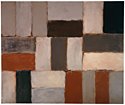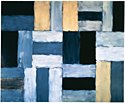Sean Scully's "Wall of Light"
Fall afternoon light streamed into the Met’s mezzanine where I saw the exhibition of Sean Scully’s “Wall of Light” series. Scully painted the first watercolors of the series in 1983-4 when he was studying the stone walls of Maya ruins in the Yucatan. These watercolors look like studies. Their basic element is the brick-like oblong, arranged in sets of three in one painting, and in sets of four in another. Six other works experiment with the use of one, two or multiple colors.
Scully returned to these watercolors in the 90s and after, developing them into a series of meditations on the concrete and the evanescent, the abstract and the figurative. The “walls” comprise bricks, or stripes, with soft edges, colors that don’t stay within their lines, and brushstrokes that evoke what the curatorial note calls “a blurry luminosity.” In many of these paintings, for example, “Wall of Light Dark Orange,” 2001, the same color shines between the bricks, suggesting a light behind the wall. The grid that underlies the paintings recalls Mondrian but offers mood and place instead of cool intellectualism. It is a geometry rooted in geography.

"Wall of Light Dark Orange," 2001
In “Wall of Light Desert Night,” 1999, the cream-colored bars indicate sand while the darkening blues evoke twilight. In “Green Pale Light,” 2002, rural Mooseurach, a small town at the base of the Alps, where Scully has a studio, is seen in the greens, browns and grays. “Chelsea Red Wall of Light,” 2005, is ochre and white.

"Wall of Light Desert Night," 1999
Actually I find these abstract landscapes less compelling than the even less representational works. The painting I like best is the blue, white, pink and black “5.4.03,” 2003. (Unfortunately I can't find its online image.) It does not have bricks; it has blocks. The thickness of the rectangles and their strict alignment convey powerfully the impact of solidity. That the painting is a piece of paper suggests its pathos.
Scully returned to these watercolors in the 90s and after, developing them into a series of meditations on the concrete and the evanescent, the abstract and the figurative. The “walls” comprise bricks, or stripes, with soft edges, colors that don’t stay within their lines, and brushstrokes that evoke what the curatorial note calls “a blurry luminosity.” In many of these paintings, for example, “Wall of Light Dark Orange,” 2001, the same color shines between the bricks, suggesting a light behind the wall. The grid that underlies the paintings recalls Mondrian but offers mood and place instead of cool intellectualism. It is a geometry rooted in geography.

"Wall of Light Dark Orange," 2001
In “Wall of Light Desert Night,” 1999, the cream-colored bars indicate sand while the darkening blues evoke twilight. In “Green Pale Light,” 2002, rural Mooseurach, a small town at the base of the Alps, where Scully has a studio, is seen in the greens, browns and grays. “Chelsea Red Wall of Light,” 2005, is ochre and white.

"Wall of Light Desert Night," 1999
Actually I find these abstract landscapes less compelling than the even less representational works. The painting I like best is the blue, white, pink and black “5.4.03,” 2003. (Unfortunately I can't find its online image.) It does not have bricks; it has blocks. The thickness of the rectangles and their strict alignment convey powerfully the impact of solidity. That the painting is a piece of paper suggests its pathos.


Comments